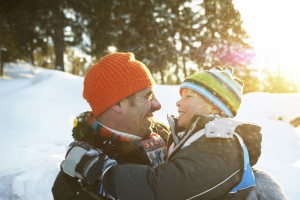Winter is here already, and along with it comes many family activities for all to enjoy. But did you know that in 2010 over 400,000 children were treated in the hospital for winter sports-related injuries?
While many children love winter, because they get to go sledding, skiing and play hockey, these winter activities are leading causes of many injuries. Here are some top tips for keeping fun number one, and preventing common injuries.
Common injuries
Skiing and snowboarding are popular winter sports, but they cause many common injuries: contusions, sprains, fractures, head injuries and joint injuries. Studies have shown that children have a higher rate of ski-related lower body fractures than adults, most of which are preventable with proper equipment. Hockey is another popular winter sport, but it accounts for nearly half of all traumatic brain injuries in Canadian children and young adults. Recent studies have shown that over 80% of children and teenagers with brain injuries were male and that most injuries occurred from player-to-player contact or being hit into the boards. The risk of such injuries can be decreased by proper education and equipment, such as wearing a helmet and mouth guard.
Prevention is a key way to decrease the likelihood of your child suffering a sports-related injury this winter
Here are some helpful tips to prevent your child from winter sports injuries:
- Keep them in shape and ensure they are properly warmed-up before they begin their activity. When muscles are cold, they are more likely to get injured.
- Encourage your child to wear the appropriate protective equipment for their sport like goggles, helmets, gloves, and protective padding. Helmets have been shown to reduce up to 50% of head injuries in contact and collision sports like hockey, skiing and snowboarding.
- Don’t forget to check their equipment regularly and ensure it fits properly. Improperly-fitting, malfunctioning or old protective equipment is a major reason for injuries.
- Encourage your child to drink plenty of water before, during and after their sport to keep them well hydrated.
- If your child is injured, encourage them to avoid participating in the sport and rest appropriately.
- If the sport takes place outdoors, monitor the weather and ensure the conditions are safe.
- Never let your child ski or snowboard alone. The American Academy of Pediatrics suggests that proper supervision is key to preventing many injuries in children.
If you know a child who has suffered a winter sports-related injury or for more information on preventing these types of injuries, feel free to contact us for more information.

